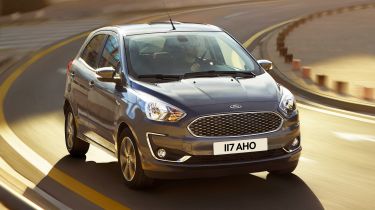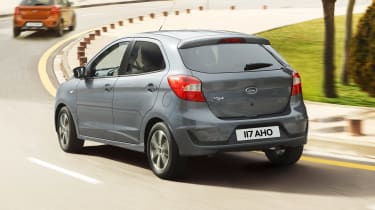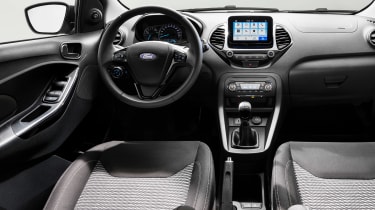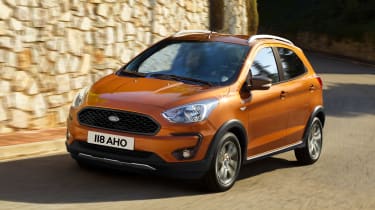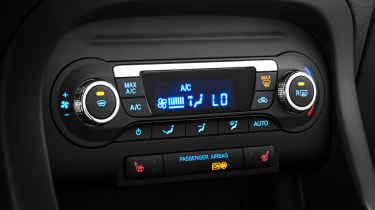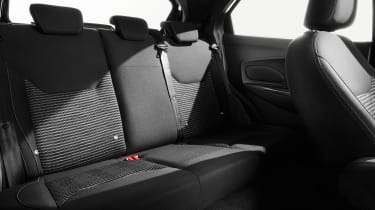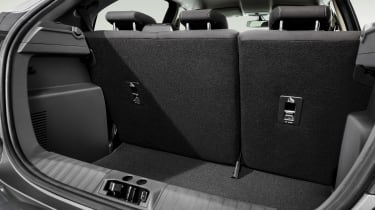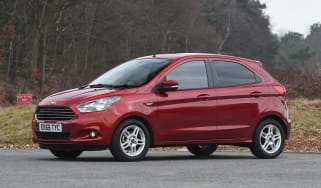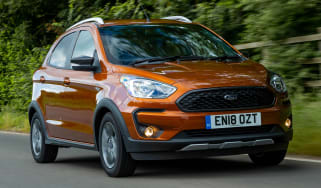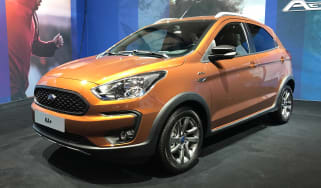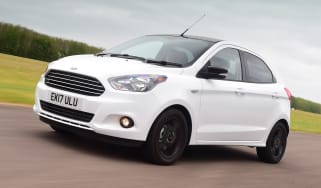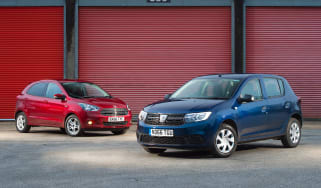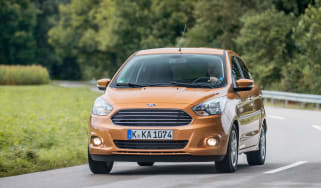Ford Ka+ (2016-2020) review
The Ford Ka+ is a roomy but bland budget supermini that competes on price with smaller city cars

The Indian built Ford Ka+ competes in a segment dominated by fun and fashionable runabouts such as the SEAT Mii, Volkswagen up!, Peugeot 108, Citroen C1, Toyota Aygo and Renault Twingo.
The Ford’s design may look unimaginative compared to the majority of its city car rivals, but it’s the Ka+ dimensions that are the model’s chief selling point. Based on the same engineering platform as the Fiesta supermini, the Ka+ has a distinct advantage when it comes to interior space. It’s a relatively roomy five-seater, yet the affordable Ka+ price list puts it in direct competition with the city car crowd, instead of the larger models in the class above.
It’s a completely different strategy to the original Ka launched back in the 1990s, when the baby Ford’s funky styling was one of its primary attractions. The Ka+ for sale today is just 40mm shorter than the Fiesta, and a similar amount taller, which makes it ideal for the less mature car markets such as India and South America for which it was actually designed.
The basic design is a disadvantage of offering a car like this here in Europe, but the build quality and refinement do pass muster at the price – indeed Ford has implemented a raft of technical upgrades to make sure the Ka+ is fit for purpose.
The UK Ka+ spec differs from home market versions thanks to a front anti-roll bar that’s nearly 50 per cent stiffer, improved springs and damping, Fiesta-spec engine mounts, extra sound proofing, uprated door seals, revised suspension bushes, a beefed-up front sub-frame and faster steering response. There’s other stuff too, but suffice to say Ford has gone to some lengths to ensure the Ka+ doesn’t face the sort of criticism aimed at the EcoSport SUV, which is another developing market model sold in the UK, but without the same level of extra preparation work.
More reviews
There are three trim levels to choose from: the entry-level Studio, a Zetec version that sits above it, and the Active. The Active gains chunky body trims and a subtly raised ride height to give it a tough 4x4 look.
The range is powered by the choice of a 1.2-litre naturally aspirated petrol engine and a 1.5-litre turbo diesel. There are two different petrol power outputs to choose from, and while the Zetec is available with both, the Studio only gets the lower power unit and the Active the more powerful option. A five-speed manual gearbox is the only transmission available, which sends its power to the front wheels.
The Ka+ is a strong showing from Ford, offering plenty of practicality in a small hatchback at affordable prices. However, you pay the price for this in terms of design, even though interior quality is acceptable.
The Ka+ range was updated for 2018, bringing with it mild styling changes, the introduction of a new SUV-like ‘Active’ trim level and a new 1.2-litre three-cylinder engine in place of the old 1.2 four pot. It’s a significant improvement over the old unit, but it’s still not quite as easy to live with every day as the small capacity turbocharged alternatives you’ll find in some rival city cars.
Very few of its rivals are as fun to drive though. The Ka+ handles and steers nicely, yet rides more smoothly than most competitors, too.
Engines, performance and drive
The Ka+ engine line-up was overhauled for 2018, with a choice of one diesel and two petrol engines.
The all-new petrol has the same 1.2-litre capacity as before, but gets three cylinders as opposed to the outgoing car’s four. There are two power outputs to choose from. Entry level Studio models have 69bhp, the Active has 84bhp, and the middling Zetec trim comes with both.
The main benefit it driveability: the latest 1.2 produces around 10 per cent more torque at low revs, meaning that it doesn’t have to be worked as hard to make progress. The new unit gives off a little vibration through the pedals, but otherwise is quieter, smoother and sounds more pleasant than the outgoing four cylinder.
Despite this, it’s still not a quick car. The more powerful engine takes 13.5 seconds to cover the 0-62mph benchmark, while the 69bhp version takes 14.6 seconds. Rivals like the Volkswagen up! are offered with a turbocharged petrol unit, which means they produce much more torque, and feel nippier in regular driving. The 1.2 feels adequate around town, but still needs plenty of effort on a motorway - a shame, as low wind noise and a smooth ride make the Ka+ one of the better city cars for covering long distances.
Extra torque is available in the form of a diesel model. The 1.5-litre TDCi produces 94bhp and 215Nm of torque, while its 11.4-second 0-62mph time makes it comfortably the most muscley option. It’s available with the Active and the Zetec, but it’s expected to only account for a tiny percentage of overall Ka+ sales. All cars come with a five-speed manual gearbox. It’s easy to use and has a positive shift action, making the Ka+ light work in heavy traffic.
While the engines are lacklustre, the Ka+ boasts arguably the finest ride and handling balance of any city car. The steering is positive, the damping ties the body down nicely, yet offers enough compliance to absorb all but the very worst bumps. A relatively long wheelbase by city car standards means that it feels very stable at high speed.
The Active rides 23mm higher than the regular Ka+, which is paired with a thicker anti-roll bar to cancel out any extra lean through the corners. It feels just as much fun to drive as the Studio and Zetec models, and slightly more comfortable, too.
Given this is a no-frills small car there aren’t any configurable driving modes. But the Ka+ doesn’t particularly need them; its honest character means it’s capable and competent rather than exciting or sporty.
Engines
We’d go for the higher powered version of the Ka+ 1.2-litre engine if the budget allows - you can only get the 69bhp version with the lowest trim level, and the extra power of the more potent option is very welcome once you approach the national speed limit.
For most of the time the difference isn’t too noticeable unless you’re asking for everything the engines have to offer. The lower power model doesn’t offer an emissions benefit, although it is cheaper if you’re looking for small car practicality on a shoestring.
The 1.5 diesel is fairly smooth, and performs strongly, though it is just a little noisier than the petrols.
MPG, CO2 and Running Costs
While the Ka+ can’t quite match the efficiency of cars such as the Skoda Citigo, it should still be relatively affordable to run. Curiously, it’s the more powerful engine that’s the more frugal: it hits a claimed 56.5mpg to the 69bhp model’s 55.4mpg. This is reflected in emissions, where the 69bhp and 84bhp cars achieve 117 and 114g/km of CO2 respectively.
Should you match those claimed figures, a 42-litre fuel tank is good for around 500 miles between fill-ups.
The 1.5 diesel promises a combined fuel consumption of 76.3mpg - about 20mpg more than the 1.2 petrol. While it’ll be a little cheaper to run, you’ll need to cover huge mileages to recoup the £1,600 you have to pay beyond the more powerful of the two petrol choices.
Insurance groups
The entry-level Studio model is only rated at group 1 in terms of insurance, so it should be cheap to cover.
Even if you upgrade to Zetec trim and add the higher power engine, the Ka+ still only comes in at group 5, so insuring the car will be relatively inexpensive no matter what model you go for. There aren’t really any options you can add to improve security and lower your premiums any further, though.
Depreciation
Depreciation is on a par with the Ka+’s main rival from Skoda and our favourite city car – the Citigo. The Ka+ Zetec will hold onto just under 40 per cent of its value from new, while the entry-level Studio model will retain slightly more of its value after three years/36,000 miles – it’ll be worth nearly 42 per cent of its original value.
These are respectable values, and while not the best in the sector, the Ka+ will retain an average amount of its purchase price, which combined with Ford’s attractive finance deals should make it affordable to buy and own.
Given it’s not as stylish or as sophisticated as cars like the Citigo, the Ford’s depreciation levels are respectable.
Interior, design and technology
The Ford’s design focuses on versatility rather than flamboyance. There are a few colour choices that liven up the exterior, but there’s only one hue that comes free of charge: white.
A few styling lines and surface contours mean it’s not quite as bland the likes of the Suzuki Celerio, but the car’s shape means it’s always going to look functional rather than fast.
It’s based on Ford’s global B small car platform that also underpins the Fiesta, so the mechanicals underneath have a proven track record. The way the car is packaged also means it’s roomy inside, which is where the practical dimensions come into their own.
• Ford Ka+ vs Skoda Citigo vs Vauxhall Viva
You can seat three adults in the rear at a push, which is still better than in many cars of a similar price. With just four fully grown humans the Ka+ is more comfortable, though, with a fair amount of legroom.
The dashboard design uses many cues from the outgoing Fiesta, so while the fascia looks a little messy in terms of its layout, at least quality is good at this level of the market. Plastics higher up in the cabin are of reasonable quality and best described as robust lower down in the cabin.
The instruments look like they were borrowed from the final generation of Escort, while there aren’t any digital screens in the binnacle to show different driving data.
Sat-nav, stereo and infotainment
The entry-level Studio trim gets electric front windows, air con, Bluetooth and a system called MyFord Dock, which clamps your smartphone to the top of the dash. This means you use the capability in your mobile device for the likes of sat-nav.
Zetec trim (expected to be the most popular with a predicted 80 per cent of sales) adds 15-inch alloys, while rear electric windows, parking sensors, automatic climate control and heated front seats are all optionally available on the top trim level.
Ford’s SYNC 3 infotainment system is fitted as standard to the Zetec and Active. The 6.5-inch touchscreen houses a slick system that’s easy to use and looks smart. If you prefer to use your smartphone’s navigation software, both Apple CarPlay and Android Auto are built in to SYNC 3. It’s a great feature to have in this class - the Volkswagen up!/SEAT Mii/Skoda Citigo trio aren’t available with a touchscreen, and the Hyundai i10 only gets one on its very highest trim level.
Practicality, comfort and boot space
There’s just one body style available in the Ka+ range, but that’s no bad thing, as the five-door shape gives plenty of practicality.
Unlike some small hatchbacks and city cars, it’s a full five seater, with a good level of space for rear passengers – the raised front seats mean you can tuck your feet under the seat in front.
Size
At 3.9 metres long the Ka+ is compact, but still slightly larger than a conventional city car. Although the Ford does straddle the line between city car and supermini, offering practicality of the latter with pricing of the former.
It’s 1.7 metres wide, making it easy to navigate through tight city streets, while the body stands more than 1.5 metres tall, which is where the decent headroom comes from.
Leg room, head room and passenger space
Despite its compact dimensions the Ka+ is roomy inside, with good head and legroom. This is thanks in part to the higher, more upright seating position made possible by the taller roof, which adds extra legroom in the rear.
The front seats have also been raised up, so while you sit high, it means rear passengers can tuck their feet under the seats in front, allowing Ford to maximise the car’s packaging.
As a result your knees won’t be jammed up against the seat in front, although anyone over six-foot tall will start to feel the squeeze. Still, for a car of this size the cabin is fairly large and practical. Isofix points mean you’ll be able to use child seats, too.
Boot
There’s a 270-litre boot with the rear seats in place – including 13 litres of underfloor storage – while this rises to a useful 849 litres if you fold the seats down. While it’s one of the biggest with its seats up, with them folded down it’s actually not quite as voluminous as a Citigo.
Other interesting features include 21 different storage locations, which Ford is particularly proud of. These include areas for bottles and trays for smartphones and other trinkets. There is a pronounced boot lip to lift bags over, however.
Reliability and Safety
As part of the tweaks to make the Ka+ more suitable for Europe, safety has been improved over the Indian-market model, where the Ka+ is built. Strengthening that has made the car better to drive has also made it stronger, so it’ll stand up to a crash better.
However, when Euro NCAP tested the Ka+ in 2017, it still only received a middling three-star rating. It was mainly let down by a lack of safety kit. ESP is standard and about the extent of it. There’s an optional City Pack, which adds rear parking sensors to help when manoeuvring, but the Ka+ isn’t that big anyway, so it’s easy to park.
With simple, proven mechanicals underpinning the car, the Ka+ should be fairly reliable. Plus there’s not much tech inside to go wrong. As a brand, Ford were below average in the 2018 Driver Power brand rankings. Out of the 26 brands included, Ford finished 16th - though that is enough to rank them more highly than rivals like Vauxhall and Peugeot, plus premium brands like BMW and Mercedes.
Warranty
Ford’s standard three-year/60,000-mile warranty is relatively standard for the industry, so the coverage offered on the Ka+ means if anything goes wrong early in your ownership it should be easy to sort, thanks to Ford’s widespread dealer network.
Of course, if you’d like the reassurance of extra cover, Ford also offer the option to extend the warranty to either four or five years. These cost extra though, and need to be purchased before the date of registration.
One year’s free roadside assistance cover means if you breakdown inside the first 12 months you’ll be covered.
Servicing
Again, the simple mechanicals mean the Ka+ should be cost-effective to keep on the road. Servicing prices are competitive for both of the petrol engines, and the diesel unit won’t be significantly more pricey to run.
Ford also offer a fixed-price servicing plan which is competitively priced.
For an alternative review of the latest Ford Ka+ hatchback visit our sister site carbuyer.co.uk
